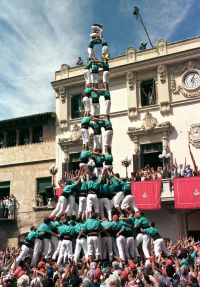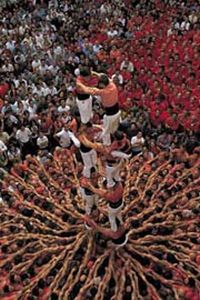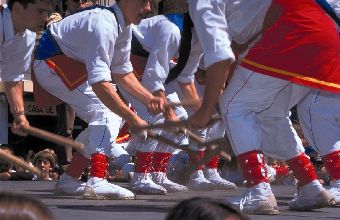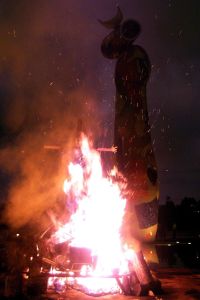

Traditions 
Catalan culture is very rich in customs and traditions that combine the feast days of the liturgical calendar with local festivities to liven up the table (with a varied gastronomic selection), as well as the streets and town squares, throughout the year.
The sardana is considered to be Catalonia’s national dance. The participants dance in a ring, hands linked, to the sound of the traditional wind instruments of a band known as the cobla. The poet Joan Maragall described it as “the most beautiful dance of all those that are made and unmade”. Other folk dances are the ball de bastons (stick dance), the jota in the Ebre region, the muixeranga (Balearic Islands) and the danses eivissenques (Ibizan dances).
As regards music, the havanera, which originated in the Caribbean, has become the typical musical backdrop to evenings by the sea, always accompanied by a rom cremat (a hot rum drink). They are songs that remind us of the colonial past, always with the sea and sailors as protagonists.
Another important cultural tradition is that of Catalonia (builders of human towers). This custom began in the Camp de Tarragona district but has now spread to other corners of the country. The castells may be as high as nine storeys (or even ten). Each level is made up of one person, or more, arranged in a circular formation and grasping each other round the shoulders. It is topped by the aixecador (the “lifter”) and the anxaneta, two small children who clamber right to the top. The castell is held to be complete when the anxaneta raises his or her hand. The tower is supported at ground level by a large group of persons who form the pinya, whose presence will also break the fall of the castellers if the structure is not successfully completed. The castell is raised to the accompaniment of the gralla (a wind instrument related to the oboe).

Castellers. © Efe
Other examples of festive traditions are the gegants (giant figures, usually regally dressed, which are carried in a dancing procession), capgrossos ((figures wearing large paper maché heads), troops of devils, trabucaires (who fire blunderbuses), xeremeiers (a wind band) and correbous (“running of the bull”).
In Spring, Saint George’s Day, 23 April, is a perfect combination of sentiment and culture. Streets and squares in every town and city are filled with roses and books. In 1995, UNESCO declared this day, on the basis of the Catalan tradition, to be International Book and Authors’ Rights Day.
Also around this time of year there is Carnival and a little later, on 19 March the falles (huge satirical sculptures in paper maché) are burnt in Valencia on the night of la cremà. In other parts of Valencia, the festival of Moors and Christians is a festive recollection of the battles and struggles between the Moors and Christians during the reconquest. In Easter week, tradition continues with the staging of passion plays, the mona de pasqua (an Easter cake) and the music of the caramelles (groups of strolling performers). In the village of Verges the so-called Dance of Death takes place.
Another outstanding event at this time of year is the Patum (in Berga, north of Barcelona), which is a festive sacrohistorical representation involving fire, music and dance, dominated by the figure of the eagle.

Castellers. © Efe
In summer, on the eve of 23 June, the shortest night of the year, coinciding with the summer solstice, the festival of Sant Joan (Saint John) takes place. This is the time of year when the sun is highest in the sky, and everywhere bonfires are lit which, they say, scare away demons, illness and misfortune, rockets rise into the sky and cava is drunk to accompany the traditional festive coca (sweet bread). In Ciutadella (Menorca) there is the remarkable festival of the caixers and cavallers, in which horses “dance” amongst the crowd.
In the autumn, on All Saints’ Day (1 November) almond sweets known as panelletes and chestnuts are traditionally eaten.
In winter, the Christmas period (Christmas day, New Year’s day and Epiphany, which in particular is very family-oriented), is associated with several specific traditions including the Tió (a Yule log that brings presents for the little ones) and the pessebre (a crib, or miniature tableau of the birth of Jesus Christ, which in Catalonia is differentiated by the presence of the caganer, a figure squatting to defecate). The Cant de la Sibil·la is a liturgical drama in Gregorian chant which is performed around Christmas in various cathedrals and churches.
In addition to all these festivities, we must not forget the festes majors, or local fiestas, with which every city, town and village celebrates its patron saint’s day.






